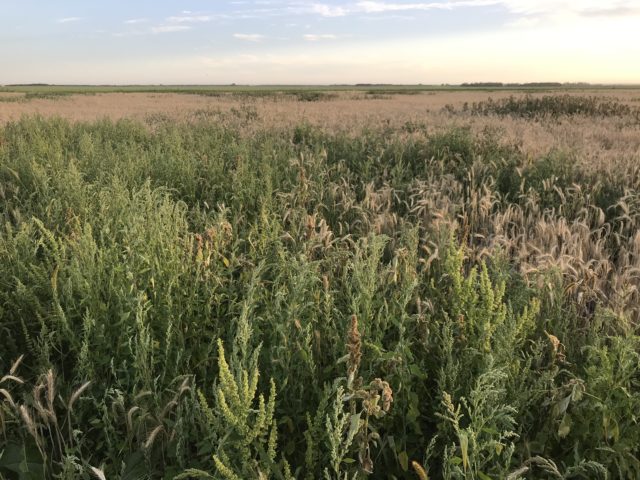
By Tammy Jones
When selecting equipment, there are spec sheets regarding horsepower and capacity, in-field demos, tires to kick and inevitably brand and colour recognition. When selecting crop varieties or hybrids, once again there are many factors taken into consideration, such as yield, height, harvestability, lodging tolerance, disease resistance even herbicide-tolerant traits. What factors are taken into consideration when selecting a herbicide? This decision seems to be less planned, even though it’s just as important to successful crop production. Planning for weed control may seem unrealistic, but has significant advantages.
Most will say that it is impossible to predict the weeds that will be an issue in the field. There is some truth that: new weeds can emerge, but in most situations, with land you’ve farmed there is an ingrained knowledge of where the weed patches are and what weeds are most challenging to control due to density, competitive ability or herbicide resistance. However, I can agree that there is no one-size-fits-all herbicide plan. Knowing which weeds are most common in your fields will help you make early management decisions. A mix of broadleaf and grass weeds usually requires a mix of chemistries for broad-spectrum control. I use the “Rule of Five,” making my weed control decision based on the five most common weeds in the field, rather than trying to fine-tune a tank-mix that will control every single weed in the field. There needs to be some degree of practicality in making decisions.
Not only will a herbicide plan address specific weed issues, it will allow for timely purchases when it makes good economic sense or gives a retail time to source product that may not be readily available in-season. In the event of herbicide resistance (already present or trying to prevent the occurrence) or particularly competitive weeds, a combination of pre-emergent and in-crop herbicides are often most effective. Herbicide layering, using a pre-emergent soil active herbicide in combination with an in-crop herbicide also allows more modes of effective action to be introduced and avoids cumbersome tank-mix situations that can end in glue or cement in the tank. Pre-emergent herbicides with residual control of grasses and broadleaves typically utilize alternate modes of action to most in-crop herbicides. The soil residual herbicide can also delay the growth of weeds, allowing for a later in-crop application and extend that period of effective weed control. The soil residual herbicide, in combination with a timely in-crop herbicide keeps the crop weed free longer, optimizing yield potential.
So, what are some of the questions that you should ask when making an herbicide plan?
1. What is your crop rotation and tillage regimen?
Crop rotation influences herbicides that can be used in-crop for weed control, as certain crops will limit herbicide options based on re-cropping restrictions. If you grow crops under a zero-tillage system, then herbicides that require incorporation will not be of use.
2. How can you incorporate multiple modes of effective action?
Herbicide resistance can derail any weed control plan. To
sustain herbicide efficacy, it is recommended that weeds are controlled with
multiple modes of effective action, i.e. more than one herbicide active
ingredient that controls the target weeds. This helps to delay resistance
development and minimizes future weed populations by reducing seed set.
3. What herbicides have you used in the
past three years?
Reading a herbicide label, there are often notes like: Maximum ONE APPLICATION per year (or every two years) of this or other products containing a certain active ingredient. Some examples of herbicides with this type of warning are pinoxaden, fluroxypyr and topramezone. If you don’t know about these type of warnings, or know what products contain these active ingredients, then how can you follow these recommendations? The sticking point here is that many active ingredients are utilized in several products at different concentrations. Without concise record keeping of herbicide applications, this question is impossible to answer.
4. Is one product really the same as another?
Patents will expire on branded products and then generic versions are offered. These products are not identical to their branded equivalents, but are similar in terms of performance, in order to be registered for use. Even within the various generic products offered, the generic products are rarely identical. A product that is deemed the “same as,” will have the same active ingredient but may differ in concentration, have different tank-mix options or could require additional adjuvant or surfactant.
5. What is the potential return on investment of an herbicide?
The price of a herbicide may not reflect that true costs of selecting a particular herbicide. Some herbicides come with an efficacy guarantee or a level of service that other products do not offer, providing some peace of mind. One box of product may require addition of surfactant, or spray modifiers that take time, effort and add complexity that is not required by another product.
That isn’t the end of the list for selecting a herbicide that is right for your farm. Your application equipment capabilities (water volume, speed, nozzle type) will have a huge impact on the effectiveness of your weed control. There is also the cost of not controlling a weed. This cost includes future weed problems, potential impact on harvestablilty and yield and quality penalties when weed control isn’t effective.
Weed control needs to be sustainable over the long-term, which is why I rarely focus on herbicides as a single tool. Integrating the selection of appropriate herbicides with other management tools will provide success in battling weeds. In addition to understanding active ingredients, the interactions (synergies, antagonism, phytotoxicity) of tank mixes, staying current on herbicide resistance populations and the impacts of weed staging and weather on herbicide efficacy, it only makes sense that a chemical plan be established with the crop rotation plan to minimize the number of last-minute decisions that are required for success. An herbicide plan will provide a better return on investment each growing season.










